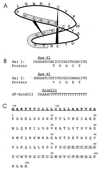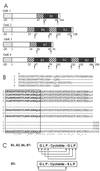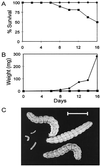Biosynthesis and insecticidal properties of plant cyclotides: the cyclic knotted proteins from Oldenlandia affinis
- PMID: 11535828
- PMCID: PMC58514
- DOI: 10.1073/pnas.191366898
Biosynthesis and insecticidal properties of plant cyclotides: the cyclic knotted proteins from Oldenlandia affinis
Abstract
Several members of the Rubiaceae and Violaceae families produce a series of cyclotides or macrocyclic peptides of 29-31 amino acids with an embedded cystine knot. We aim to understand the mechanism of synthesis of cyclic peptides in plants and have isolated a cDNA clone that encodes the cyclotide kalata B1 as well as three other clones for related cyclotides from the African plant Oldenlandia affinis. The cDNA clones encode prepropeptides with a 20-aa signal sequence, an N-terminal prosequence of 46-68 amino acids and one, two, or three cyclotide domains separated by regions of about 25 aa. The corresponding cyclotides have been isolated from plant material, indicating that the cyclotide domains are excised and cyclized from all four predicted precursor proteins. The exact processing site is likely to lie on the N-terminal side of the strongly conserved GlyLeuPro or SerLeuPro sequence that flanks both sides of the cyclotide domain. Cyclotides have previously been assigned an antimicrobial function; here we describe a potent inhibitory effect on the growth and development of larvae from the Lepidopteran species Helicoverpa punctigera.
Figures




References
-
- Craik D J, Daly N L, Bond T, Waine C. J Mol Biol. 1999;294:1327–1336. - PubMed
-
- Saether O, Craik D J, Campbell I D, Sletten K, Juul J, Norman D G. Biochemistry. 1995;34:4147–4158. - PubMed
-
- Gustafson K R, Sowder R C, II, Henderson L E, Parsons I C, Kashman Y, Cardellina J H, II, McMahon J B, Buckheit R W, Jr, Pannell L K, Boyd M R. J Am Chem Soc. 1994;116:9337–9338.
-
- Witherup K M, Bogusky M J, Anderson P S, Ramjit H, Ransom R W, Wood T, Sardana M. J Nat Prod. 1994;57:1619–1625. - PubMed
-
- Schöpke T, Hasan Agha M I, Kraft R, Otto A, Hiller K. Sci Pharm. 1993;61:145–153.
Publication types
MeSH terms
Substances
Associated data
- Actions
- Actions
- Actions
- Actions
LinkOut - more resources
Full Text Sources
Other Literature Sources

